As mentioned in an earlier post flowering was late this year. My grafted Lophophora williamsii (SB 854; Starr Co, Tx) is now making up for this by showing off its sixth flower this season.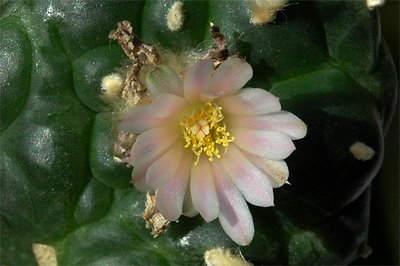
Flowering Lophophora williamsii – 6th flower this season
The three previous flowers unfolded while I was away on vacation – the remains of all the spent flowers are visible beneath the current one.
This flowering coincided with the flowering of a Lophophora williamsii v. jourdaniana. I decided not to outcross the plants but instead self-pollinate both of them; first of all to keep my SB 854’s “clean”, secondly I want to test the alleged self-incompatibility of the jourdaniana variety.
< previous | next >
Monday, July 31, 2006
Flowering Lophophora williamsii – II
Friday, July 14, 2006
Flowering Lophophora williamsii
Flowering has been late this year but finally my grafted Lophophora williamsii (SB 854; Starr Co, Tx) decided to come back with a vengeance by setting two flowers simultaneously.
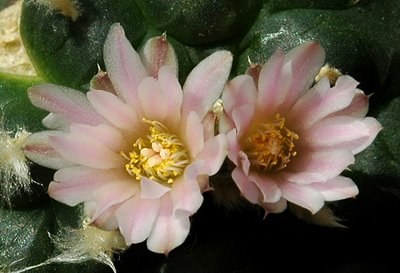
Lophophora williamsii with two flowers
The scar visible in the upper left-hand corner of the photo formed after the epidermis ripped, caused by too vigorous growth.
The flowers are funnelform, pinkish white with a light pink midstripe.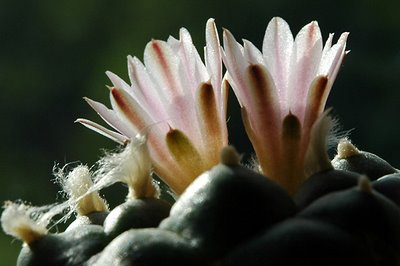
Funnelform flowers reaching for the sun
I self-pollinated the flowers but am wondering if it’s necessary – the anthers are virtually brushing the stigmas, depositing pollen without any help.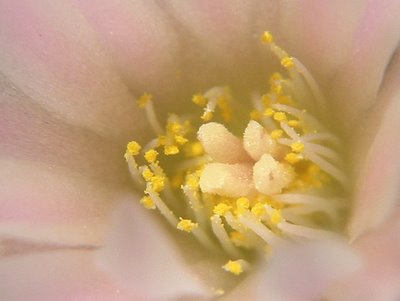
Anthers brushing stigmas
Last growing season I also posted on this plants flowering and fruit setting (use the previous and next links to navigate the posts).
< previous | next >
Thursday, July 06, 2006
Straying Lophophora williamsii flower
The July issue of Kakteen und andere Sukkulenten features an article on weird growth forms in Lophophora and Ariocarpus.
Contrary to common Lophophora behaviour with flowers emerging from the young areoles at the top of the plant, the article shows a specimen flowering from an old areole close to the root neck.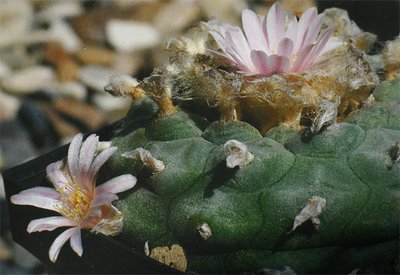
The only information available on the Lophophora specimen is that it was acquired 10 years ago as a L. williamsii var. caespitosa. The plant itself doesn’t seem to tiller, but apparently the areoles are vigorously vital ;-)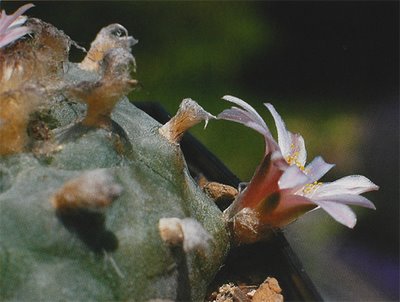
References
Uwe Schriefer (2006), "Sonderbare Auswüchse bei Lophophora und Ariocarpus", Kakteen und andere Sukkulenten 57 (7), 191–192
Tuesday, May 23, 2006
Lophophora and Epithelantha - experiments in cold hardiness
According to common belief, species from Lophophora, Epithelantha, Ariocarpus etc, do not like subfreezing temperatures. This is not entirely true - many varieties will survive temperatures dropping well below freezing. The last couple of years I've experimented with growing Lophophora, Epithelantha, and Acharagma in an unheated greenhouse, and this winter the plants had to endure temperatures below -10C (14F) for extended periods. I'm planning on growing Ariocarpus as well if I can find seeds originating from the Trans-Pecos area.
Lophophora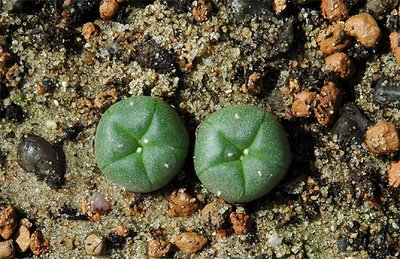
Lophophora williamsii – started from seed 2004
The picture above shows Lophophora williamsii (SB 854; Starr Co, Texas) plants sown May 1, 2004. After 2 years in the coldhouse the plants are thriving - more plants have been disfigured and killed by bush-crickets and other critters than by the cold. The remaining 5 plants are each 1.5 cm (~ 0.6'') wide.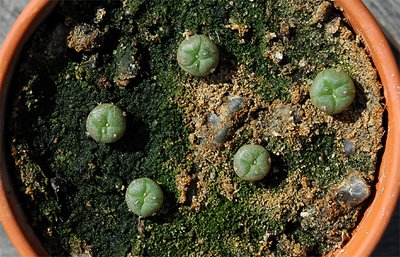
Lophophora williamsii – started from seed 2005
Last years batch of Lophophora williamsii (SB 854; Starr Co, Texas) seedlings are also doing well. The 5 plants have obtained a diameter of 1 cm (~ 0.4'').
The more southern living Lophophora diffusa is not handling the cold as well - none of the plants started from seed in 2004 are left, and only 2 plants from the 2005 crop are still surviving. The L. diffusa seeds originated from plants from Higuerillas, Queretaro. The 11 Lophophora decipiens seedlings from last year are doing slightly better, but as the L. diffusa seedlings they have only grown to a width of 0.5 cm (~0.2'').
Epithelantha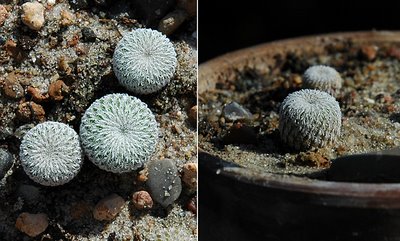
Left: E. micromeris v. greggii (Cuesta la Muralla, Coahuila)
Right: E. micromeris (SB 1327, near Belen, New Mexico)
I'm growing Epithelantha micromeris v. greggii (Cuesta la Muralla, Coahuila) and Epithelantha micromeris (SB 1327, near Belen, New Mexico). The New Mexico variety is a slow grower – the 12 plants are less than 1 cm (~ 0.4'') wide – but it is handling the cold very well. The Coahuila variety is growing faster but is more susceptible to frost damage – the 11 plants are each 1.5 cm (~ 0.6'') wide. All plants were sown May 1, 2004.
Acharagma
The Acharagma aguirreana (RSM 396; Sierra Paila, Coahuila) and Acharagma roseana (LX 578; Ramon Arizpe, Coahuila) seedlings from last year are still fairly small – less than 0.5 cm (~0.2'') in width. A. roseana seems to be better at tolerating frost than A. aguirreana; I sowed 30 seeds of each species, and 20some seedlings of each germinated. Today more than 20 A. roseana are surviving while only 3 A. aguirreana are left.
Friday, April 21, 2006
The power of grafting - IX (full circle)
It’s time to shake off the dust of the prehistoric peyote buttons from the previous post and get started with the new growing season. Two years ago today I grafted a 50some days old Lophophora williamsii (SB 854; Starr Co, Tx) seedling onto a (then extravagantly oversized) Trichocereus pachanoi stock.
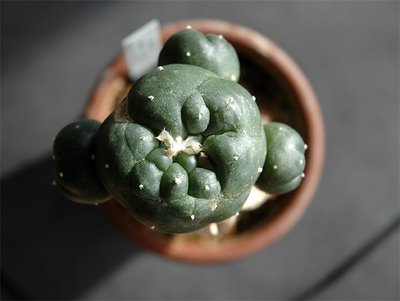
Grafted Lophophora williamsii (SB 854; Starr Co, Tx)
The plant has set 3 offshoots and grown to a width of 5.6 cm (~ 2.2'' – excluding the offshoots) and a height of 4.8 cm (~ 1.9''). It’s currently busy increasing the number of ribs from 5 to 8 (or maybe it goes directly for 13 ribs... it’s a bit hard to tell at this stage).
For comparison you can check this photo of the same graft one year ago.
Full circle
The plant flowered 4 times last year – all flowers were self-pollinated. The resulting fruits contained 22 seeds that were sown April 4, but until now only 5 have germinated and out of these only 3 seedlings are thriving. Yet another illustration of why inbreeding should be avoided.
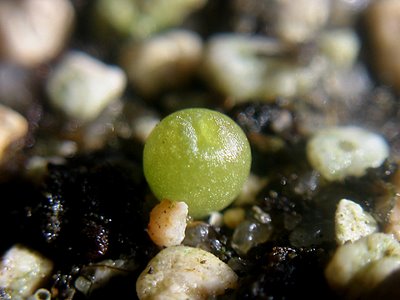
Lophophora seedling grown from self-pollinated seeds
I find it quite amazing that grafting enables you to go full circle from seedling to seedling in two years.
A more detailed account of the plant’s flowering and fruit setting can be had by following the “previous” links.
< previous | next >
Tuesday, February 28, 2006
Lophophora williamsii and Obregonia denegrii from seed
Today I sowed this years first batch of seeds - 30 each of:
- Lophophora williamsii (VM 305k; Sierra de la Paila, Coahuila)
- Lophophora williamsii (VM 183k; Hipolito, Coahuila)
- Obregonia denegrii v. prerovskyana nom. prov. (KMR 38; Cinco de Mayo, Tamaulipas)
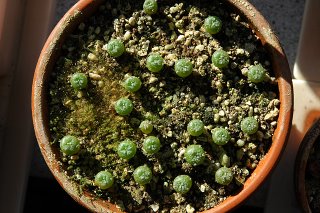 Lophophora williamsii seedlings (RS 428A; Cuatro Ciénegas, Coahuila)
It's amazing that cactus seedlings can thrive for a year in the humid environment of a sowing bag (notice the green stuff among the seedlings - it's moss!), but it seems to become them well.
Lophophora williamsii seedlings (RS 428A; Cuatro Ciénegas, Coahuila)
It's amazing that cactus seedlings can thrive for a year in the humid environment of a sowing bag (notice the green stuff among the seedlings - it's moss!), but it seems to become them well.
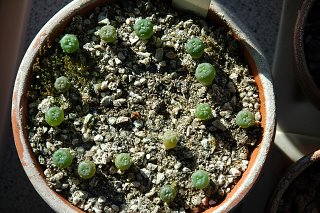 Lophophora diffusa seedlings (RS 1193; Peña Miller, Queretaro)
The benefits of growing in bags are many, e.g. you don't need to water often and most pests like red spider mites are avoided (on the other hand you have to be careful not to let in sciarid flies). On the downside, the plants seem slightly leggy - probably because they haven't been fully dormant throughout winter.
Lophophora diffusa seedlings (RS 1193; Peña Miller, Queretaro)
The benefits of growing in bags are many, e.g. you don't need to water often and most pests like red spider mites are avoided (on the other hand you have to be careful not to let in sciarid flies). On the downside, the plants seem slightly leggy - probably because they haven't been fully dormant throughout winter.
Wednesday, February 15, 2006
The power of grafting – VIII
My grafted Lophophora williamsii (SB 854; Starr Co, Tx) is growing its last fruit this season. The fruit looks ripe and fat so I'm hoping for lots of seeds even though the flower was self-pollinated.
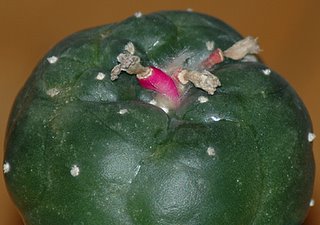
Lophophora williamsii - ripe fruit
Yesterday I harvested the dried fruits produced by the plants second and third flower – both of these flowers were also self-pollinated (I didn’t have a whole lot of plants flowering last year ;-)
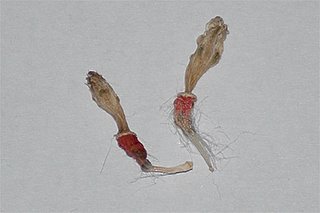
Lophophora williamsii - harvested fruits
The fruits are approximately 1 cm (~0.4'') long, only the upper half is containing seeds. The yield from these fruits, each contained 6 seeds, is much better than from the first fruit I harvested.
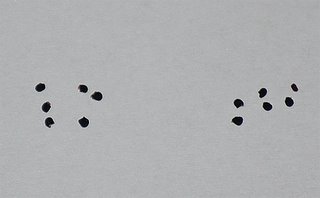
Lophophora williamsii - seeds
If the seeds are viable I hope to come full circle, growing new seedlings in less than two years after the mother plant was sown!
< previous | next >
Wednesday, January 18, 2006
Variegated and cristate Lophophora
Many Thai nurseries are offering large selections of variegated and crested cacti. Unfortunately the Lophophora plants are quickly sold out so I haven’t obtained any yet. The photos below are courtesy of Deaw Cactus.
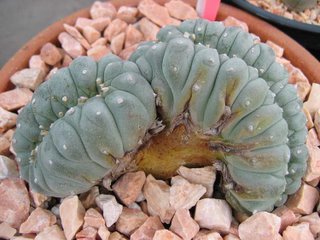
Lophophora williamsii crest (own root) – 13cm
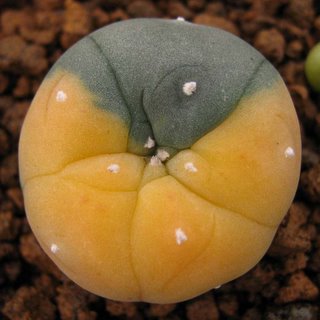
Variegated Lophophora williamsii – 3.5cm
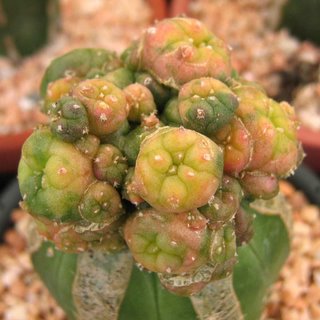
Variegated Lophophora williamsii v. caespitosa – 6cm
Tuesday, December 27, 2005
Munching on Lophophora williamsii - II
My cold house grown Lophs have been maimed by some critter eating big, hearty lumps out of them. There are no traces of snails so I expect the culprit to be a grasshopper or bush-cricket trapped in the house.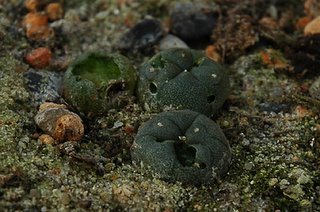
Maimed Lophophora williamsii (SB 854; Starr Co, Texas)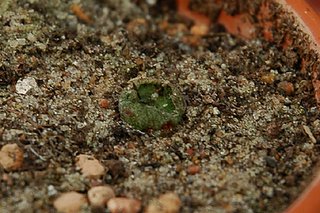
Lophophora diffusa (JR; Higuerillas, Queretaro) remains
The plants above were sown May 1, 2004 and have grown in the cold house since. Some of this year’s Lophophora seedlings were also taken out by the “unwanted guest”.
I’ve wrapped the pots in horticultural fleece and hope this will keep the culprit out in the future.
Saturday, November 26, 2005
The power of grafting – VII
Most of my plants are now dormant and I hadn’t expected much activity to report on these pages – but 5 days ago I noticed a budding fruit on my grafted Lophophora williamsii (SB 854; Starr Co, Tx).
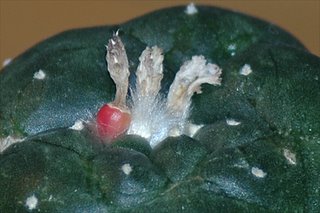
Budding Lophophora williamsii fruit
The fruit is now ripe and slightly longer than 1 cm (~ 0.4’’) with a diameter of 4.5 mm (~ 0.2’’) at the widest section. The color is best described as a pinkish magenta segueing into a lighter pink on the surface not directly exposed to the sun.
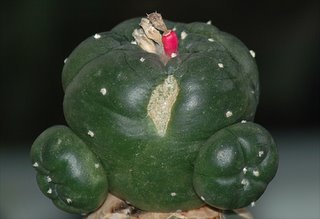
Lophophora williamsii with ripe fruit
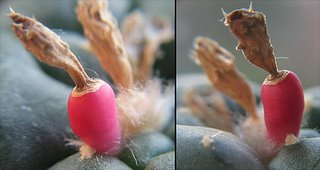
Lophophora williamsii fruit – close-ups
While examining the plant it became apparent that another fruit is breaking out. If this one ripens as abruptly as the last, it will be fully extruded within a week.
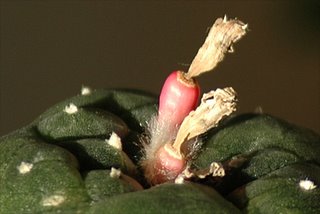
Fruiting Lophophora williamsii
< previous | next >
Sunday, October 23, 2005
The power of grafting - VI
Today I harvested the first seeds from my grafted Lophophora williamsii (SB 854; Starr Co, Tx). The fruit appeared mid-September and has been maturing on the plant for some weeks. The photo below shows the fruit on September 17.
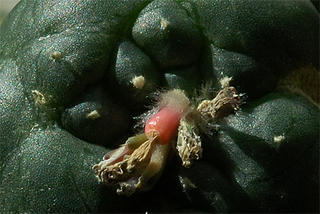
Lophophora williamsii fruit
The fruit has been dry and ripe for picking for a while now – as illustrated by the next photo, taken just before the fruit was removed.

Dry Lophophora williamsii fruit
I blame it on the self-fertilization; the fruit only contained 3 seeds that looked OK and 2 that weren’t fully developed. It will be interesting to see if any of the seeds are viable.
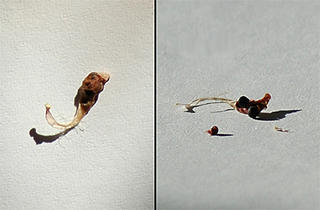
Lophophora williamsii seeds
< previous | next >
Monday, September 12, 2005
The power of grafting - V
My grafted Lophophora williamsii (SB 854; Starr Co, Tx) is on a roll – it is now flowering for the fourth time this year.

Lophophora williamsii flower
I self-pollinated the flower and collected some pollen for a Lophophora williamsii v. jourdaniana that will flower soon – allegedly this variety is self-incompatible i.e. it requires outcross pollination. I hope the pollen will stay viable in the refrigerator for a week or two.
< previous | next >
Monday, August 29, 2005
The power of grafting - IV
For the third time this year my grafted Lophophora williamsii (SB 854; Starr Co, Tx) is flowering – quite an accomplishment from a plant only 18 months from seed (sowed February 29, 2004). This flower was also self-pollinated.

Flowering Lophophora williamsii
The two spent flowers can be seen below the current one.
< previous | next >
Monday, August 22, 2005
The power of grafting - III
My grafted Lophophora williamsii (SB 854; Starr Co, Tx) is flowering again (and yet another bud is in the works). Once again I had to self-pollinate the flower since none of my other plants are blooming.
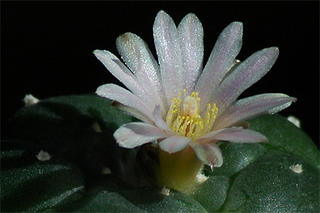
Flowering Lophophora williamsii
Growth will tear us apart
The scion is growing so hard you can practically hear the epidermis squeaking. A couple of days ago it gave in to the pressure and burst – maybe triggered by the plant “rearranging itself”, starting to grow more ribs. The scion has grown to a width of 5 cm (~1.97’’), excluding the offshoots.
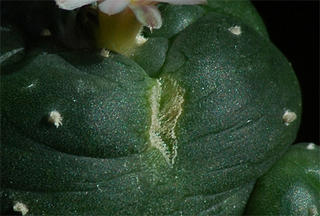 .
.
Bursting Lophophora williamsii
The Echinopsis (Trichocereus) pachanoi stock refuses to give up the fight and is stubbornly growing yet another offshoot.
< previous | next >
Monday, August 15, 2005
Munching on Lophophora williamsii
Until lately my coldhouse grown Lophophora williamsii (SB 854; Starr Co, Tx; sowed May 1, 2004) were dazzling in their immaculate appearance – until some critter decided to munch on them.

Munched on Lophophora
The main shoot of my Cylindropuntia tunicata was maimed too. A search of the cacti revealed a great green bush-cricket (Tettigonia viridissima) hiding among the plants. I took the mug shot below before releasing the suspected culprit outdoors.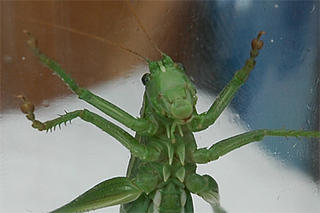
Captured great green bush-cricket
The harm is not too great and I expect the plants to fully recuperate from the damage.
Monday, July 25, 2005
The power of grafting - II
In less than one and a half years my grafted Lophophora williamsii (SB 854; Starr Co, Tx) has grown from a minute seedling to a mature plant, flowering for the first time. The Lophophora scion is 4.85 cm (~1.9’’) wide and has grown 3 offshoots; the flower is a typical pinkish white with a somewhat darker midstripe, and is 1.8 cm (~0.7’’) wide. None of my other plants are currently blooming so I attempted to self-pollinate the flower.
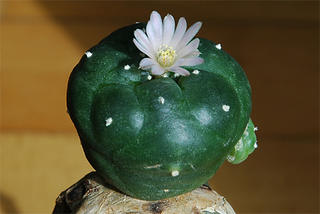
Flowering Lophophora williamsii graft
The Echinopsis (Trichocereus) pachanoi stock is striving to get a life of its own – since the previous post I’ve removed two offshoots. Even though it slows the growth of the Lophophora scion down a bit, I let the shoots grow for as long as they don’t intimidate the scion. The removed shoots are rooted and will be used for future grafts.
< previous | next >
Sunday, July 24, 2005
Sowing in the rough - III
I’m not sure if it’s the seed, the coldhouse environment or sheer coincidence, but in addition to the deviating growth forms described in an earlier post one of the Lophophora williamsii (SB 854; Starr Co, Texas) seedlings turned out achlorophyllous.
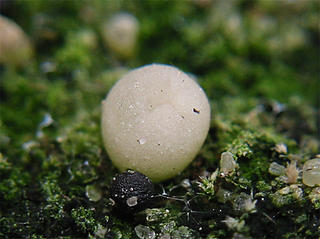
Achlorophyllous Lophophora williamsii
The seedling lacks chlorophyll and will not survive on its own roots for long so I grafted it on Pereskiopsis spathulata – hopefully it will survive and prosper.
< previous |
Monday, July 18, 2005
Seedling grafting on Pereskiopsis - II
Well, my first experience with grafting on Pereskiopsis spathulata was a limited success – limited by a combination of stupidity and clumsiness. I ignored the advice of experts and watered the Pereskiopsis plants heavily before grafting. As a result the small seedling scions were soon sailing away on a sea of cactus sap. When trying to correct this I managed to knock off half of the scions. Despite this treatment two of the grafts took (one each of L. williamsii, RS 428A, Cuatro Ciénegas, Coahuila and L. diffusa RS 1193, Peña Miller, Queretaro). Especially the Lophophora williamsii graft is doing great – in 11 weeks it’s grown to a width of 1.9 cm (0.75’’).
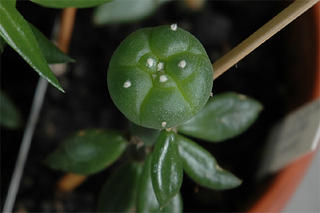
Lophophora williamsii seedling grafted on Pereskiopsis spathulata
The Pereskiopsis spathulata plants are easy to grow. I planted the ‘waste products’ from the graft, and along with the plants where the graft didn’t take, they now make up a shrubbery that would make even the Knights who say ‘Ni’ happy.
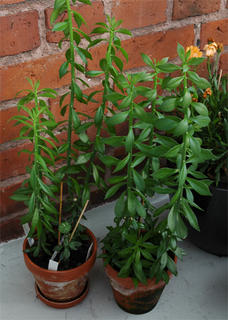
Pereskiopsis spathulata ‘shrubbery’
The hardest part of growing Pereskiopsis is to remember to give them a generous treatment with plenty of water ;-)
< previous |
Monday, July 11, 2005
Sowing in the rough - II
Some of the Lophophora williamsii (RS 268; Huizache, San Luis Potosí) seedlings are developing interesting growth forms. One is clearly dichotomous (a simple type of branching in plants where the apical meristem splits at various intervals) and another shows signs of an extension of the apical meristem into a ridge - I'll watch it closely to see if it develops a crest.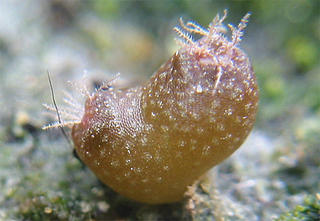
Dichotomous Lophophora williamsii seedling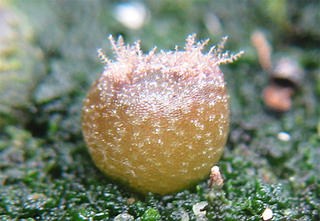
Lophophora williamsii seedling with a crest meristem?
< previous | next >
Friday, May 27, 2005
Flowering Nestor
Today the oldest cactus in my collection (a Lophophora williamsii named Nestor;-) flowered for the first time this year. I bought it in 1992 as a small plant in a flower shop, i.e. I don’t know the exact age of the plant nor do I have any locality information (except that it probably originates from a commercial Dutch grower ;-).

Lophophora williamsii in flower

The flower backlit by the sun
The photo of the backlit flower doesn’t do full justice to the sight – the sunlit flower has an almost mother-of-pearl sheen to it.
All Time Most Popular Posts
-
Lophophora williamsii (peyote) populations have diminished in large areas of South Texas where peyoteros harvest the cactus for ceremonial ...
-
On various occasions I've been asked what growing media I'm using for my cactus plants. I don't have a set soil mix recipe as su...
-
Below is a list of retailers/nurseries selling cactus seed and plants. I've only listed vendors I've done business with. If you ar...
-
Most cacti are easily grown from seed - and with a little patience and care they can be grown into beautiful plants. Lophophora williamsi...
-
In last month’s post on the troubled Texan peyoteros I referred to Anderson’s article on the peyote situation in Texas. Given the importanc...
-
Yet another slightly off topic and probably not entirely politically correct post, but I couldn’t help noticing the similarity of my monstr...
-
Flowering stand of San Pedro cacti (Trichocereus pachanoi) To me the main draw of the San Pedro cactus ( Trichocereus pachanoi (syn. Ech...
-
In the June 2008 issue of the Cactus & Co magazine Jaroslav Šnicer, Jaroslav Bohata, and Vojtěch Myšák described a new Lophophora spec...
-
There seems to be an increased focus on the alarming Texas peyote situation. A couple of weeks ago the Houston Press published a mournful, i...
-
I spent two weeks working in Delhi, India during January. I had one weekend off and had planned to spend it in Delhi at my own leisure, but ...


















